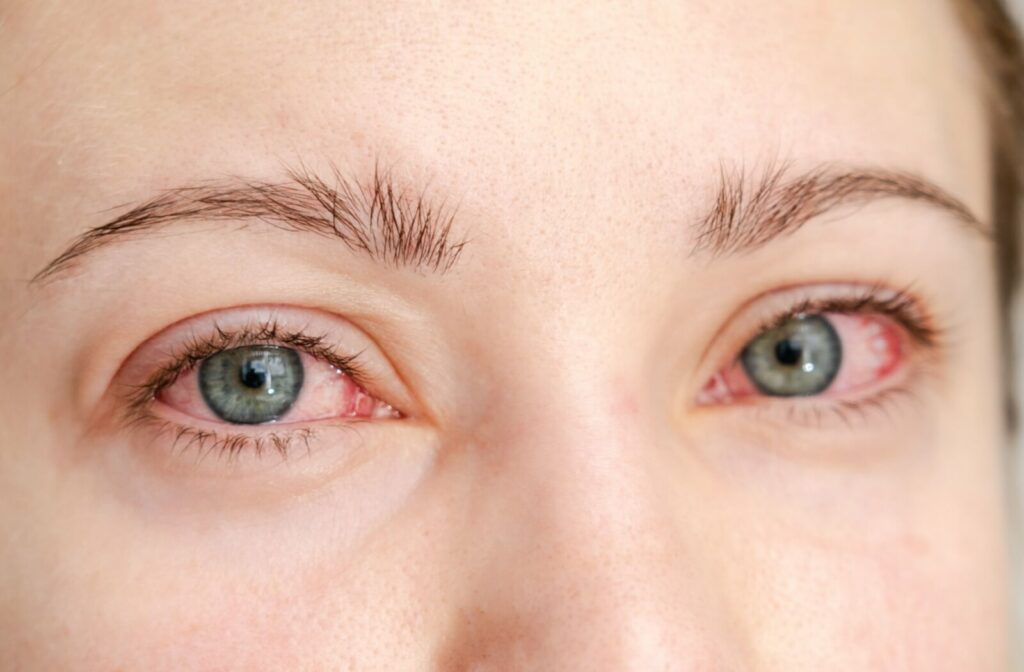Eye irritation is one of the most common medical complaints for families, students, and professionals. And when it comes to red, watery, or itchy eyes, many people quickly assume the cause must be pink eye (medically known as conjunctivitis). But did you know that several other conditions, such as dry eye, iritis, and styes can mimic the symptoms of pink eye? Misdiagnosing these conditions can lead to improper treatment, with prolonged discomfort and potentially threaten vision.
At Waterloo Vision Care Clinic, we’re dedicated to helping you understand your eye health, so you can make informed decisions for yourself and your family.
What is Pink Eye?
Pink eye, or conjunctivitis, is an inflammation of the conjunctiva—the thin, transparent tissue layer that lines the inside of your eyelid and covers the white part of your eye. This condition has various causes, ranging from infections to irritants, and it presents with symptoms like:
- Redness in the white part of the eye or the inner eyelid
- Itchy, burning sensation in the eyes
- Increased tear production
- Discharge, often grey or yellow, especially noticeable after waking up
- Blurred vision and sensitivity to light (in some cases)
Pink eye can affect one or both eyes and spread from one to the other. Depending on the cause, it can be highly contagious or completely non-contagious.
Conjunctivitis can be caused by:
- Viruses (such as the common cold or COVID-19)
- Bacteria
- Chemicals (like chlorine or smoke)
- Allergens (such as pollen or pet dander)
While pink eye is often mild, understanding its source—and distinguishing it from other conditions—is important for proper treatment.
Conditions Often Mistaken for Pink Eye?
Pink eye shares symptoms with many other eye conditions, leading to frequent misdiagnoses. It is therefore important that anyone with signs of pink eye be seen by an eye care professional who has the equipment and tools to make a proper diagnosis. Here are the most common culprits and how to tell them apart:
Dry Eye Syndrome
Dry eyes occur when your eyes don’t produce enough tears or when tears evaporate too quickly. This can result in redness, irritation, and even a gritty sensation—all of which can resemble conjunctivitis. However, dry eye is not contagious and is often linked to factors like screen usage, aging, medications, or environmental conditions.
Treatment: Dry eye is usually addressed with artificial tears, lifestyle adjustments, and sometimes prescription treatments to stimulate tear production. If you’re experiencing persistent dryness, we recommend visiting our clinic for tailored solutions.
Iritis
Iritis is the inflammation of the iris (the coloured part of the eye) and causes redness, light sensitivity, and blurry vision. While iritis may look like pink eye at first glance, it is a more serious condition that affects deeper parts of the eye and typically requires urgent care. Iritis may be a sign of other systemic health conditions.
Treatment: Iritis often requires prescription corticosteroids or other anti-inflammatory medications to reduce inflammation. Prompt treatment is crucial to avoiding complications.
Styes
A stye is a red bump on the edge of the eyelid, caused by an infection in an eyelash follicle or oil gland. The redness and swelling around the eye can mimic conjunctivitis, but styes are usually localized to the eyelid and are accompanied by a pus-filled center.
Treatment: Applying warm compresses several times a day can help the stye drain naturally. Good eyelid hygiene is essential, and in some cases, antibiotics may be prescribed.

Blepharitis
Blepharitis is chronic inflammation of the eyelids, often caused by skin conditions like rosacea or bacterial infections. Symptoms include red, swollen eyelid edges, flaking at the base of the eyelashes, and general irritation—often mistaken for pink eye.
Treatment: Blepharitis requires consistent eyelid hygiene with warm compresses and cleansing solutions. More serious cases may need antibiotics or steroid eye drops.
Keratitis
Keratitis is inflammation of the cornea, the clear, dome-shaped surface that protects the front of the eye. Similar to pink eye, keratitis can cause redness, watery eyes, and blurred vision. However, keratitis is typically accompanied by significant discomfort and light sensitivity and can result from wounds, infections, or prolonged contact lens wear.
Treatment: Depending on the cause, treatment may include antifungal, antiviral, or antibiotic eye drops, along with pain management. Left untreated, keratitis can lead to more serious complications.
Differentiating Pink Eye Types
Even if your symptoms are indeed caused by pink eye, it is important to determine the specific type of conjunctivitis to provide the correct treatment.
- Bacterial conjunctivitis can come from touching your eyes with unclean hands, sharing personal care items (like makeup) and typically requires antibiotic eye drops or ointments.
- Viral conjunctivitis can come from common colds, flu, or COVID-19 exposure and usually self-resolves within two weeks. Lubricating drops and cold compresses can help with symptoms.
- Allergic conjunctivitis is triggered from pollen, dust, or pet dander, which can be treated with antihistamines or allergy eye drops. Avoiding allergens is key.
- Chemical conjunctivitis from irritants like smoke or chlorine is generally treated by flushing the eye with saline and avoiding the irritant.
How to Prevent Eye Irritation and Pink Eye
While not all cases of eye irritation or pink eye can be avoided, there are several steps you can take to reduce your risk of developing these conditions. Practicing good hygiene and protecting your eyes in everyday situations can go a long way in preventing both infectious and non-infectious eye issues.
Tips for Prevention:
- Wash your hands frequently and avoid touching your eyes, especially with unwashed hands.
- Avoid sharing personal items like towels, makeup, or eye drops.
- Clean your contact lenses properly and never wear them longer than recommended.
- Take regular breaks from screens to reduce dry eye symptoms.
- Use protective eyewear in environments with dust, chemicals, or bright lights.
- Manage allergies proactively with antihistamines and air purifiers, especially during allergy seasons.
Small daily habits can play a big role in keeping your eyes healthy and free from irritation or infection.
Why Proper Diagnosis Matters
Eye discomfort might seem like a minor inconvenience, but incorrect self-diagnosis can lead to inappropriate treatment—or even make the problem worse. For example, using antibiotic drops for a viral or allergic condition may not only be ineffective but also delay healing.
An optometrist can perform a detailed eye exam to distinguish between similar-looking conditions like pink eye, iritis, or keratitis. At Waterloo Vision Care Clinic, our diagnostic tools allow us to look beneath the surface of your symptoms and get to the root cause.
Accurate diagnosis means:
- More effective treatment
- Faster recovery
- Reduced risk of complications
- Peace of mind
Trust your instincts—if something doesn’t feel right with your eyes, it’s worth getting checked by a professional.
Key Takeaways
- Pink eye (conjunctivitis) is a common eye condition, but its symptoms can mimic other, more serious issues like iritis, keratitis, or blepharitis.
- Not all red or watery eyes are caused by infection—conditions like dry eye, allergies, and styes can appear similar.
- Proper diagnosis from an eye care professional is essential to avoid improper treatment and protect your vision.
- Pink eye can be viral, bacterial, allergic, or chemical in origin—each type requires a different approach to care.
- If symptoms persist, worsen, or affect vision, consult an optometrist as soon as possible.
When to Seek Professional Care
If your eye discomfort persists despite basic care, or if symptoms worsen, it’s time to visit an eyecare professional. Potential signs of a more serious condition include intense discomfort, sensitivity to light, or any changes in vision.
At Waterloo Vision Care Clinic, we offer comprehensive eye health evaluations using advanced diagnostic tools. Our team prioritizes both your eye health and overall comfort, helping provide personalized care that fits your needs.




